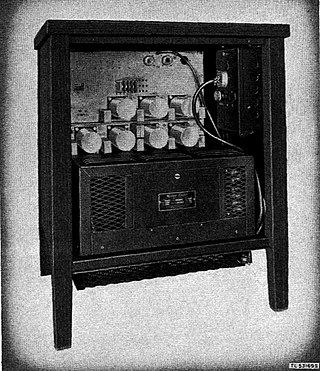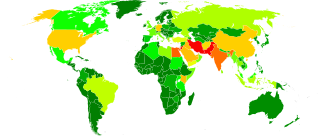
In cryptography, encryption is the process of encoding information. This process converts the original representation of the information, known as plaintext, into an alternative form known as ciphertext. Ideally, only authorized parties can decipher a ciphertext back to plaintext and access the original information. Encryption does not itself prevent interference but denies the intelligible content to a would-be interceptor.

The National Security Agency (NSA) is an intelligence agency of the United States Department of Defense, under the authority of the Director of National Intelligence (DNI). The NSA is responsible for global monitoring, collection, and processing of information and data for foreign intelligence and counterintelligence purposes, specializing in a discipline known as signals intelligence (SIGINT). The NSA is also tasked with the protection of U.S. communications networks and information systems. The NSA relies on a variety of measures to accomplish its mission, the majority of which are clandestine. The NSA has roughly 32,000 employees.

In cryptography, the one-time pad (OTP) is an encryption technique that cannot be cracked, but requires the use of a single-use pre-shared key that is larger than or equal to the size of the message being sent. In this technique, a plaintext is paired with a random secret key. Then, each bit or character of the plaintext is encrypted by combining it with the corresponding bit or character from the pad using modular addition.

Signals intelligence (SIGINT) is the act and field of intelligence-gathering by interception of signals, whether communications between people or from electronic signals not directly used in communication. As classified and sensitive information is usually encrypted, signals intelligence may necessarily involve cryptanalysis. Traffic analysis—the study of who is signaling to whom and in what quantity—is also used to integrate information, and it may complement cryptanalysis.
The U.S. National Security Agency (NSA) used to rank cryptographic products or algorithms by a certification called product types. Product types were defined in the National Information Assurance Glossary which used to define Type 1, 2, 3, and 4 products. The definitions of numeric type products have been removed from the government lexicon and are no longer used in government procurement efforts.

William Frederick Friedman was a US Army cryptographer who ran the research division of the Army's Signal Intelligence Service (SIS) in the 1930s, and parts of its follow-on services into the 1950s. In 1940, subordinates of his led by Frank Rowlett broke Japan's PURPLE cipher, thus disclosing Japanese diplomatic secrets before America's entrance into World War II.

TEMPEST is a U.S. National Security Agency specification and a NATO certification referring to spying on information systems through leaking emanations, including unintentional radio or electrical signals, sounds, and vibrations. TEMPEST covers both methods to spy upon others and how to shield equipment against such spying. The protection efforts are also known as emission security (EMSEC), which is a subset of communications security (COMSEC).
The known-plaintext attack (KPA) is an attack model for cryptanalysis where the attacker has access to both the plaintext and its encrypted version (ciphertext). These can be used to reveal secret keys and code books. The term "crib" originated at Bletchley Park, the British World War II decryption operation, where it was defined as:
A plain language passage of any length, usually obtained by solving one or more cipher or code messages, and occurring or believed likely to occur in a different cipher or code message, which it may provide a means of solving.

The TSEC/KW-26, code named ROMULUS, was an encryption system used by the U.S. Government and, later, by NATO countries. It was developed in the 1950s by the National Security Agency (NSA) to secure fixed teleprinter circuits that operated 24 hours a day. It used vacuum tubes and magnetic core logic, replacing older systems, like SIGABA and the British 5-UCO, that used rotors and electromechanical relays.

The TSEC/KL-7, also known as Adonis was an off-line non-reciprocal rotor encryption machine. The KL-7 had rotors to encrypt the text, most of which moved in a complex pattern, controlled by notched rings. The non-moving rotor was fourth from the left of the stack. The KL-7 also encrypted the message indicator.
The National Security Agency took over responsibility for all U.S. Government encryption systems when it was formed in 1952. The technical details of most NSA-approved systems are still classified, but much more about its early systems have become known and its most modern systems share at least some features with commercial products.

This glossary lists types of keys as the term is used in cryptography, as opposed to door locks. Terms that are primarily used by the U.S. National Security Agency are marked (NSA). For classification of keys according to their usage see cryptographic key types.
The 5-UCO was an on-line one-time tape Vernam cipher encryption system developed by the UK during World War II for use on teleprinter circuits. During the 1950s, it was used by the UK and the US for liaison on cryptanalysis.
Redaction or sanitization is the process of removing sensitive information from a document so that it may be distributed to a broader audience. It is intended to allow the selective disclosure of information. Typically, the result is a document that is suitable for publication or for dissemination to others rather than the intended audience of the original document.
Below is a timeline of notable events related to cryptography.

SIGCUM, also known as Converter M-228, was a rotor cipher machine used to encrypt teleprinter traffic by the United States Army. Hastily designed by William Friedman and Frank Rowlett, the system was put into service in January 1943 before any rigorous analysis of its security had taken place. SIGCUM was subsequently discovered to be insecure by Rowlett, and was immediately withdrawn from service. The machine was redesigned to improve its security, reintroduced into service by April 1943, and remained in use until the 1960s.

A fill device or key loader is a module used to load cryptographic keys into electronic encryption machines. Fill devices are usually hand held and electronic ones are battery operated.

Bullrun is a clandestine, highly classified program to crack encryption of online communications and data, which is run by the United States National Security Agency (NSA). The British Government Communications Headquarters (GCHQ) has a similar program codenamed Edgehill. According to the Bullrun classification guide published by The Guardian, the program uses multiple methods including computer network exploitation, interdiction, industry relationships, collaboration with other intelligence community entities, and advanced mathematical techniques.

The practice of mass surveillance in the United States dates back to wartime monitoring and censorship of international communications from, to, or which passed through the United States. After the First and Second World Wars, mass surveillance continued throughout the Cold War period, via programs such as the Black Chamber and Project SHAMROCK. The formation and growth of federal law-enforcement and intelligence agencies such as the FBI, CIA, and NSA institutionalized surveillance used to also silence political dissent, as evidenced by COINTELPRO projects which targeted various organizations and individuals. During the Civil Rights Movement era, many individuals put under surveillance orders were first labelled as integrationists, then deemed subversive, and sometimes suspected to be supportive of the communist model of the United States' rival at the time, the Soviet Union. Other targeted individuals and groups included Native American activists, African American and Chicano liberation movement activists, and anti-war protesters.

NESTOR was a family of compatible, tactical, wideband secure voice systems developed by the U.S. National Security Agency and widely deployed during the Vietnam War through the late Cold War period of the 1980s. NESTOR consists of three systems. The KY-8 was used in vehicular and afloat applications; the KY-28 was the airborne version; and the KY-38 was the portable or man-pack model. About 30,000 NESTOR equipments were produced prior to their replacement by the VINSON secure voice family.














